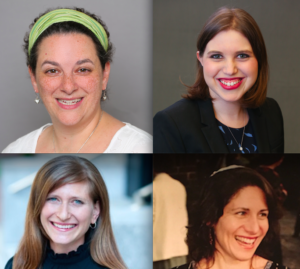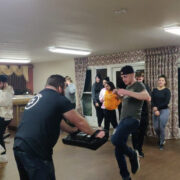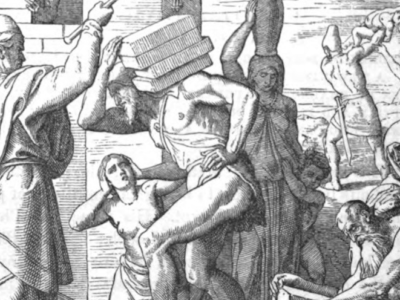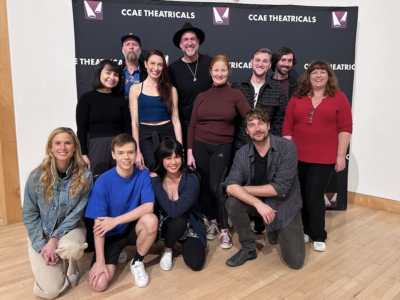
The four Jewish female religious leaders who spoke about feminism and Purim. Top row: Rabbi Ilana Garber (left) and Maharat Dasi Fruchter. Bottom row: Rabbi Leora Kaye (left) and Rabbi Margot Stein.
By Alina Dain Sharon/JNS.org
In the Book of Esther’s Chapter 4, verse 14, Mordechai encourages his niece, Queen Esther, to use her influence with King Ahasuerus.
“For if you remain silent at this time, relief and deliverance for the Jews will arise from another place, but you and your father’s family will perish. And who knows but that you have come to your royal position for such a time as this?” he tells her.
Esther listens to Mordechai and manages to save the Jewish people from annihilation, while Ahasuerus’s previous wife Vashti is remembered for refusing to obey the king.
Ahead of the Purim holiday March 11-12, which falls this year shortly after International Women’s Day March 8, here are interviews with four female religious leaders from different Jewish denominations for their perspectives on the lessons contemporary women can glean from the Purim story, and on their own paths toward religious leadership.
Reform: Rabbi Leora Kaye
“We all have opportunity to change the world, to make it more just or more compassionate. It might have just been that for this moment today, that’s why we’ve been put on this Earth,” reflects Rabbi Leora Kaye, director of programs at the Union for Reform Judaism (URJ), on Mordechai’s aforementioned words to Esther.
Kaye, who received her rabbinical ordination from Hebrew Union College-Jewish Institute of Religion in New York in 2002 and served in many leadership roles in the Reform Jewish community before joining URJ, believes there are women like Esther who don’t realize that they have power and need encouragement to be stronger than they believe they can be.
As the daughter of a director of camping and youth activities in the Reform community, Kaye grew up immersed in Jewish education. While she was initially unsure if she wanted to become a pulpit rabbi, along the way she encountered “a lot of Mordechais” who encouraged her to study in rabbinical school. She also pursued her love of filmmaking by working as a television writer and producer, notably on the Sundance Film Festival award-winning documentary Blue Vinyl.
Kaye notes that the idea of feminism is a lot older than what most might believe, citing not only the Purim story, but also other biblical storylines such as those involving the midwives Shifra and Puah, who defied Pharaoh’s order to kill all newborn Jewish boys, or the daughters of Zelophehad, who fought for their right to inherit property. Though they do not represent the majority voice in the Bible, “there are strains in these stories that imply to me that even back then, there were people who thought about women’s rights,” she says.
In her own professional life, Kaye says she has faced little resistance, though “every so often someone will look at me and say, ‘Oh you don’t look like a rabbi,’ and laugh.”
“I know I stand on the shoulders of the women who came before me,” she says.
Conservative: Rabbi Ilana Garber
Rabbi Ilana Garber says she admires Esther for using “her voice and her power to her advantage, and in strategic ways.”
“What might be interpreted as her silence — when she does not tell the king her real name and her ancestry — is actually discretion. A strong feminist knows how to use words and actions to make a difference,” Garber explains.
Garber, the associate rabbi at Beth El Temple in West Hartford, Connecticut, graduated from the Jewish Theological Seminary in 2005. She is a member of several national committees of the Conservative movement’s Rabbinical Assembly, and of Rabbis Without Borders, which seeks to redefine what it means to be a rabbi and share the word of the Torah in new, pluralistic ways. Garber has garnered attention for writing about raising a child with Fragile X syndrome.
When she was a child in the early 1980s, Garber did not know that women could be rabbis. In fact, her male rabbi told her that women should not have equal roles in Jewish ritual practice. She changed her perspective, at age 11, after meeting a female Reform rabbi who took her under her wing.
In the years that followed, Garber faced obstacles such as synagogues that only wanted to hire male rabbis or congregants who would ask while she marched holding the Torah if they should kiss the Torah or kiss her, as well as challenges in the dating world. She says it is “not easy to tell a nice Jewish boy that you are a rabbi,” going as far as lying to her current husband when they first met that she was a “community educator.”
Garber is motivated by the Purim story’s Esther to consider the figurative masks that people wear to disguise themselves, their inner needs and their desires.
“How might we learn to be more honest?” she asks.
“Some days I feel the need to proudly march with my feminist flag,” says Garber. “I seek to have a voice in a room full of male rabbis, or to create meaningful and engaging programs for women…But other days, I am ‘just’ a rabbi, and gender plays very little into who I am or what I do. Still, even on those days, being a feminist — someone who knows how to speak her mind and use her actions in order to achieve her goals — is my primary motivation.”
Reconstructionist: Rabbi Margot Stein
Rabbi Margot Stein, a faculty member at the Reconstructionist Rabbinical College (RRC), calls the Purim story as a whole “sexist” because “the two primary women are being manipulated” for their body and beauty, and Esther herself must use “manipulation” to access power.
“Just because the book is named the Book of Esther doesn’t make it feminist, or Esther a feminist character,” Stein says.
Having earned a Master of Hebrew Letters and rabbinical degree from RRC in 1997, Stein is also a musician who has recorded and co-produced seven albums of Jewish music. In 1988, she co-wrote a song that depicts her belief that Esther and even Vashti have “redeeming qualities.” The song, titled “She said NO to the king,” describes Vashti as refusing “to be a woman oppressed” and Esther discovering that she needs to use “her mind” to get out of her “bind.”
The Purim story is about women “learning how to be active on the world stage,” says Stein, who was raised in a Conservative home and attending a synagogue with an Orthodox rabbi, and noticed how her brother received greater access to Jewish education than she did. As she came of age, she became “increasingly interested in the feminist version of Judaism.”
In the Purim story, Ahaseurus had a harem of women, which Stein views as a parallel to today’s sex trafficking. She notes the importance of organizations that fight problems like trafficking, such as T’ruah: The Rabbinic Call for Human Rights.
“I am inspired by the Purim story to continue fighting for women’s rights in all places where they’re not realized,” she says.
Orthodox: Maharat Dasi Fruchter
“What I think is most feminist about the Purim story is actually the fact that there’s collaborative leadership between a man and a woman (Mordechai and Esther),” says Maharat Hadas (Dasi) Fruchter—a graduate of Yeshivat Maharat and the assistant spiritual leader at Beth Sholom Congregation and Talmud Torah of Potomac, Maryland.
“Esther is given a lot of airtime, which in itself is a feminist thing,” Fruchter explains, though she adds that she doesn’t believe Esther’s goal was to be a feminist. Instead, the story provides a “glimpse into the narrative of a complex woman.”
Growing up modern Orthodox, Fruchter later discovered Yeshivat Maharat, the first institution to ordain women as Orthodox clergy, through one of its founders. She calls her experience there “a beautiful match to my passions and strengths.”
While some of the school’s graduates take the title of “rabbi,” Fruchter uses “maharat”ca Hebrew acronym for manhiga hilkhatit rukhanit Toranit. This reflects the institution’s policy that Orthodox congregations, even those who accept women as clergy, have varying levels of comfort with the concept of women rabbis.
“There have definitely been times where I’ve had hateful things said to me…I see it as people who are afraid of change in various capacities,” says Fruchter.
“My job is to keep doing my work,” she says, noting that while the status of women in Orthodox Judaism varies, opportunities for Orthodox women to learn Torah are increasing.
Fruchter points out that when she refuses to appear before the king, Vashti uses similar wording to what Joseph uses when he refuses to sleep with his Egyptian master’s wife in Genesis. Fruchter often uses the Vashti-Joseph comparison to teach young girls about sexual consent. She also uses Mordechai’s words in Esther 4:14 — that Esther may have been meant for the moment — as a mantra to re-evaluate her own decisions at every moment, and how she can be “harnessing it for good.










Comments